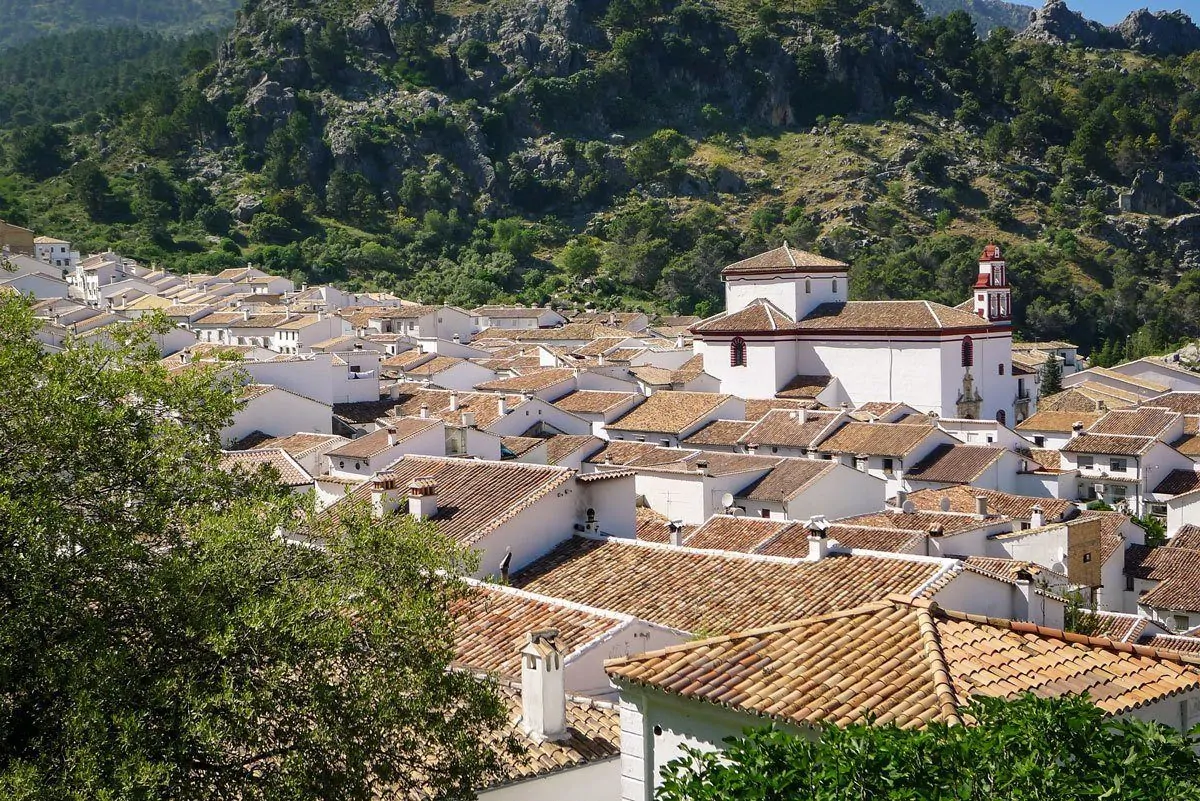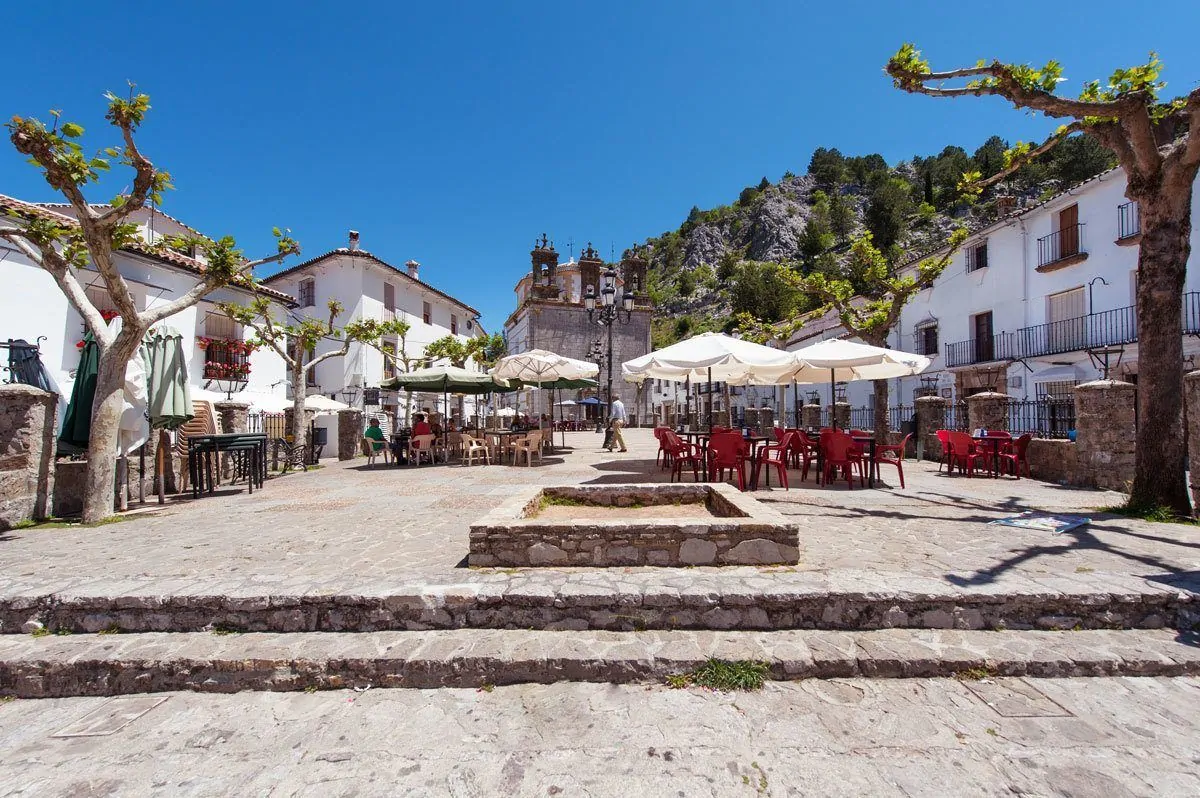If you are planning a trip to Spain and the famous Andalucían cities of Granada or Seville, why not extend your Southern Spain itinerary to include one of Spain’s most scenic driving routes – Ruta de los Pueblos Blancos (the Route of the White Villages).
A route so beautiful, it is also one of the most popular cycling and walking routes in Spain for multi-day self-guided walking holidays.
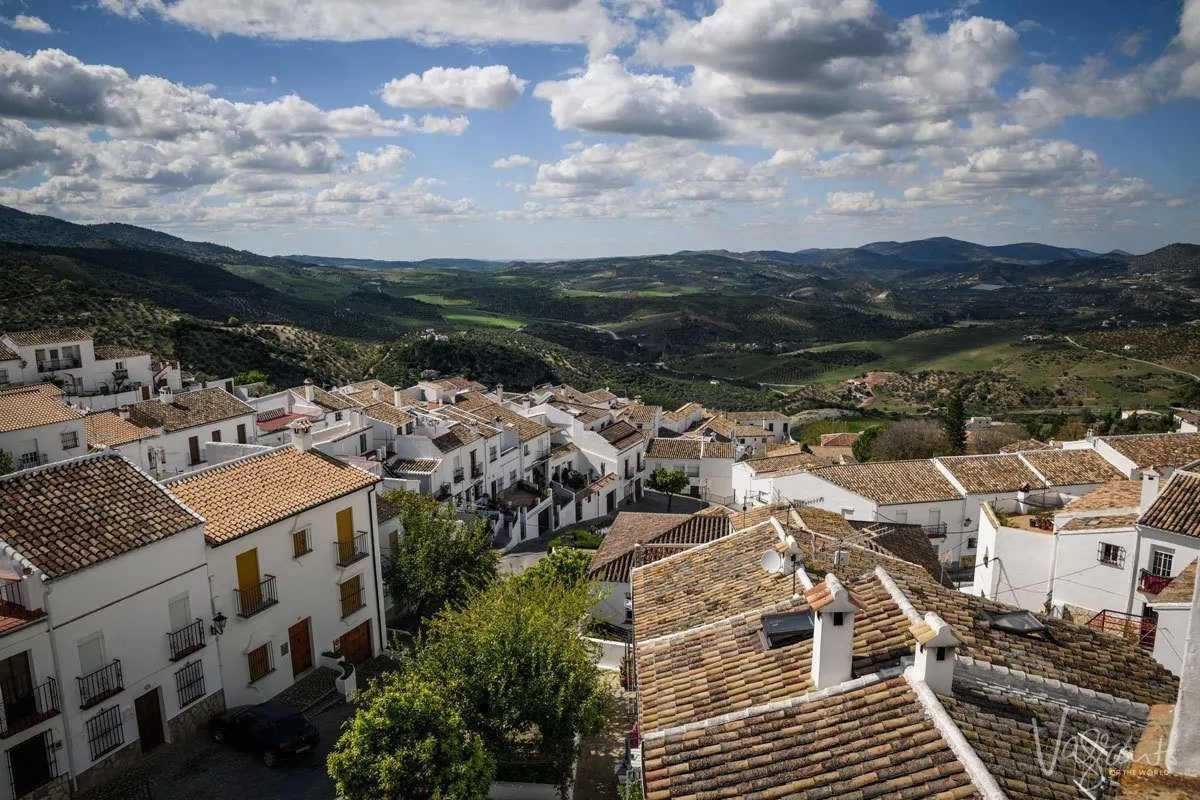
What is the White Villages Route and What Are the Pueblos Blancos
Rated as one of the best places to visit in Southern Spain, the White Villages Route is a stunning drive that runs through 19 municipalities in Andalucía in southern Spain. As the name suggests, the route passes through beautiful villages and towns characterised by white houses painted with lime to protect against the heat.
Bright white villages cascade from ancient castles down mountains in the lush Andalucían countryside. Some emerge from beneath the rock face of the landscape; each has its unique characteristics and heritage.
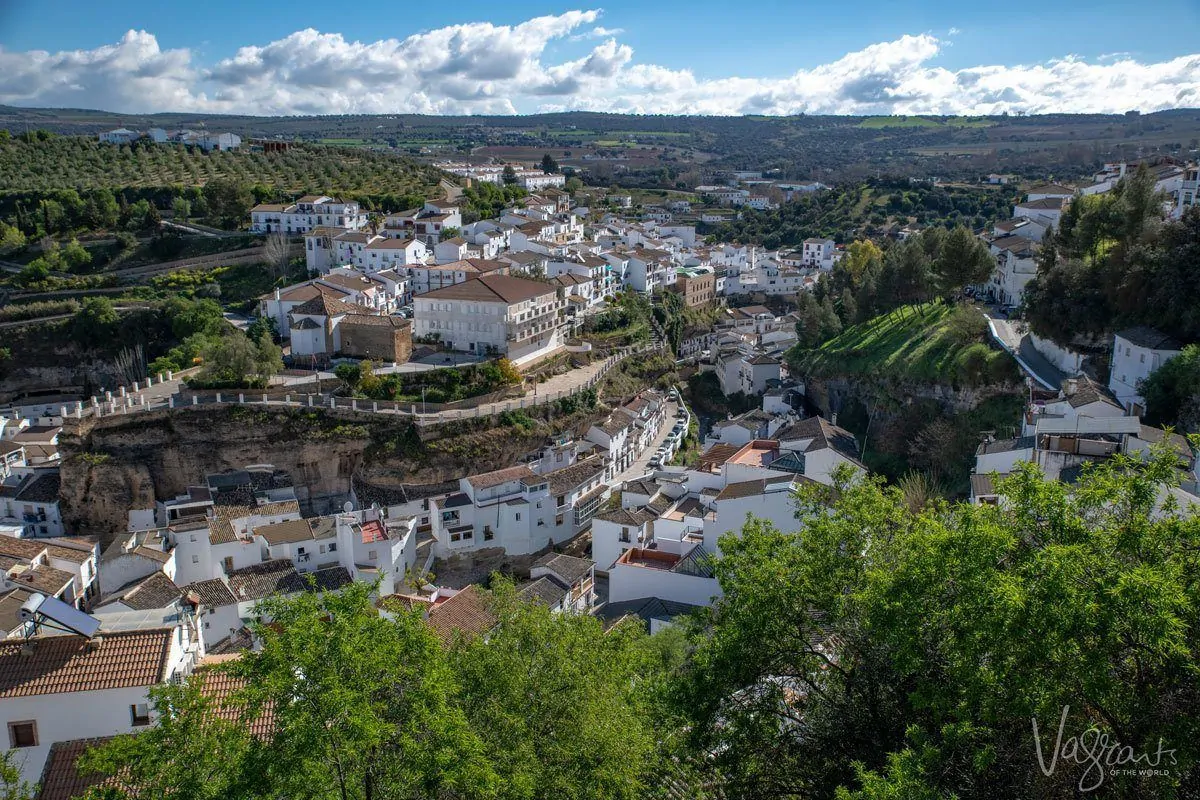
The area settled in prehistoric times has an extraordinary heritage and shares some of the more intriguing aspects of Spain– Prehistoric cave paintings and towns that still have occupied cave dwellings, Moorish influences, fortified castles and magnificent Gothic, Renaissance and Baroque cathedrals. The area is also known for its typical and delicious gastronomy.
Where are the Pueblos Blancos White Villages
The White Towns of Andalucía are in the northern parts of the Cádiz and Málaga provinces, mostly clustered around the Sierra de Grazalema Nature Park.
The first villages are a little over an hour from Seville and less than an hour from Cádiz. Some of the Pueblos Blancos around the Sierra de Grazalema are so close to each other; it is easy to visit a few in one day.
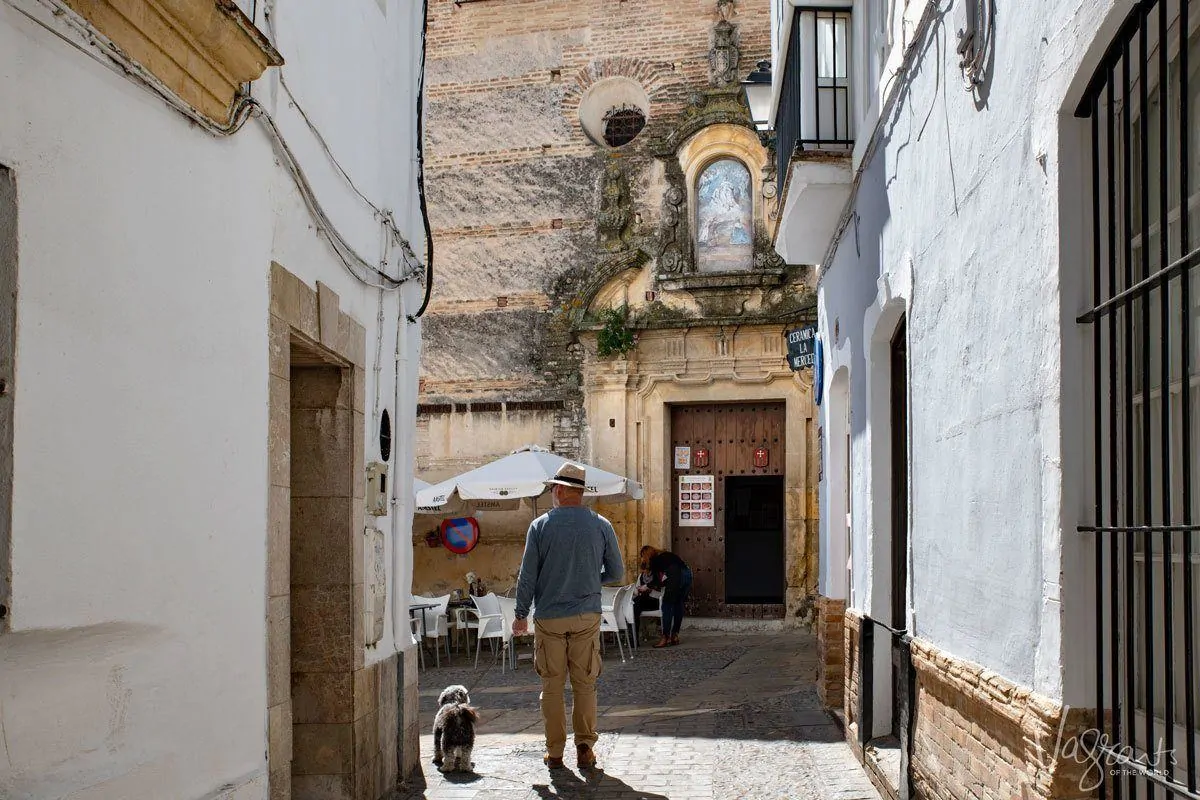
Visiting The White Villages
To do justice to the entire 19 Pueblos Blancos and the larger city of Ronda, no less than a week to visit, explore and most of all, enjoy them all would be ideal.
However, knowing many visitors to Andalucía may not have an entire week, we have put together a fantastic 3-day circular road trip from Seville. A 3-day itinerary takes in the Pueblos Blancos best without rushing. Six of the most beautiful and interesting white villages in the Cádiz region, each town an easy drive to the next.
The itinerary also allows for two nights in Ronda, the most popular and largest white village in Andalucía. While Ronda is technically one of the white villages, it is often left off the list of the 19 Pueblos Blancos due to its size compared to the surrounding villages.
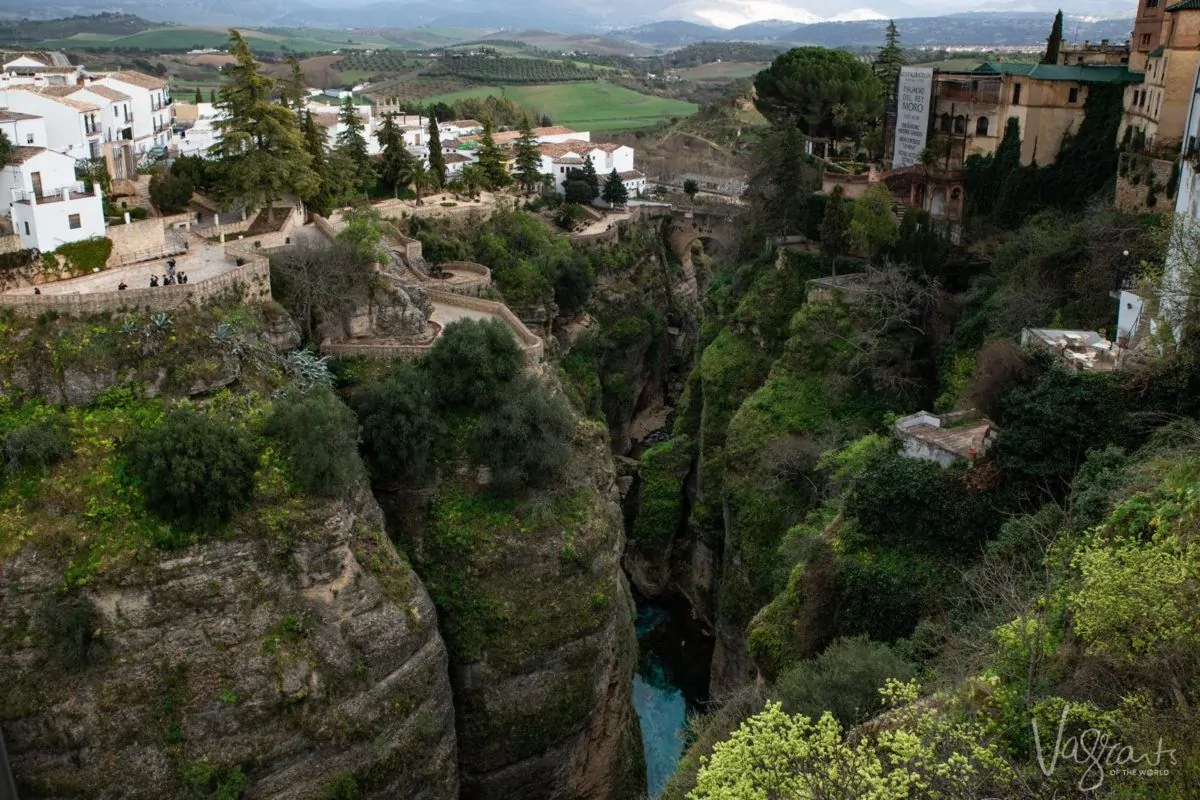
How to Get to the White Villages of Spain
Self Drive
While relatively close together, the White Villages of Spain are not well connected via public transport, which is why our 3-day Pueblos Blanco’s itinerary is based on self-drive.
Car hire from Seville is very reasonable for a small to midsize 4 door vehicle perfect for this kind of trip. Search Discover Cars for the best rates from local car rental companies with no additional fees and free cancellation.
White Villages Tours
If you don’t want to do a self-drive tour of the Pueblos Blancos, a few small group tours are available that will give you a similar experience.
2 Day/1 Night From Seville
Take a 2 day/1 night tour of the Sierra de Grazalema Mountains from Seville. Visit some of the white villages in the region, including Ronda and local wineries. Tour includes overnight accommodation in Ronda, guides, and transport. Prices start from €199 pp. See here for full details.
3 Day/4 Night Mini Cycling Tour From Ronda
Want something more active? Take a 3 day/4 night White Villages Mini Cycling Tour. Starting and finishing in Ronda, enjoy five uniquely different white villages and the beautiful Andalucían countryside. The tour includes all your cycling gear, 4 nights’ accommodation, breakfast, and luggage transfers. Prices start at €575 pp. See full details here.
The area is also perfect for a self-guided cycling tour. You can find some of the best touring bikes here– the itinerary can follow the same route as a road trip.
Ruta de los Pueblos Blancos. 3 Day White Villages Itinerary
Distances Between the White Villages of Southern Spain
Seville – Arcos de la Frontera |
1.11 hr |
86.3 km |
Arcos de la Frontera – Zahara de la Sierra |
47 min |
52.6 km |
Zahara de la Sierra – Grazalema |
33 min |
20.6 km |
Grazalema – Ronda |
42 min |
31.8 km |
Ronda – Setenil de las Bodegas |
30 min |
17.8 km |
Setenil de las Bodegas – Olvera |
30 min |
16.0 km |
Olvera – Seville |
1.20 hr |
100 km |
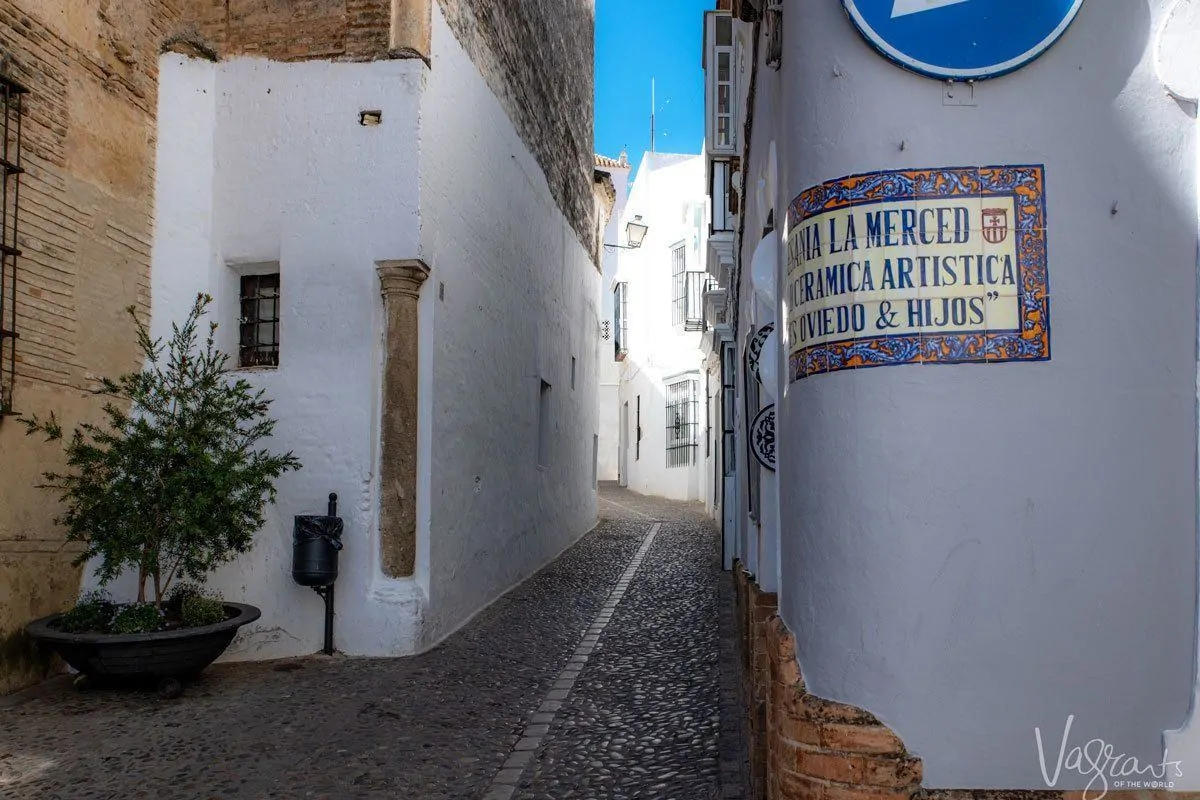
DAY 1
- Depart Seville
- Arcos de la Frontera
- Zahara de la Sierra
- Grazalema
- Ronda
Without having to leave too early, depart Seville in the morning to be in Arcos de la Frontera mid-morning. You will have enough time to explore and enjoy an early lunch sampling some of the local tapas dishes the town is well known for.
The next stop of Zahara de la Sierra also makes a delightful spot for lunch or even a progressive lunch as it is less than an hour along the route. It is hard to resist the local tapas dishes in each of the villages, so why not make the most of it with a mini tapas tour of the villages.
In the afternoon, head further into the mountains to the village of Grazalema to take in the stunning vistas and quaint mountain village vibe. Arrive in Ronda late afternoon in time to relax before the typically late Spanish dinner crowd begin to head out.
Seville
Seville is the vibrant capital of Andalucía and the birthplace of Flamenco. Starting and finishing a 3-day Andalucían itinerary from Seville is one of the best ways to experience the best of Southern Spain.
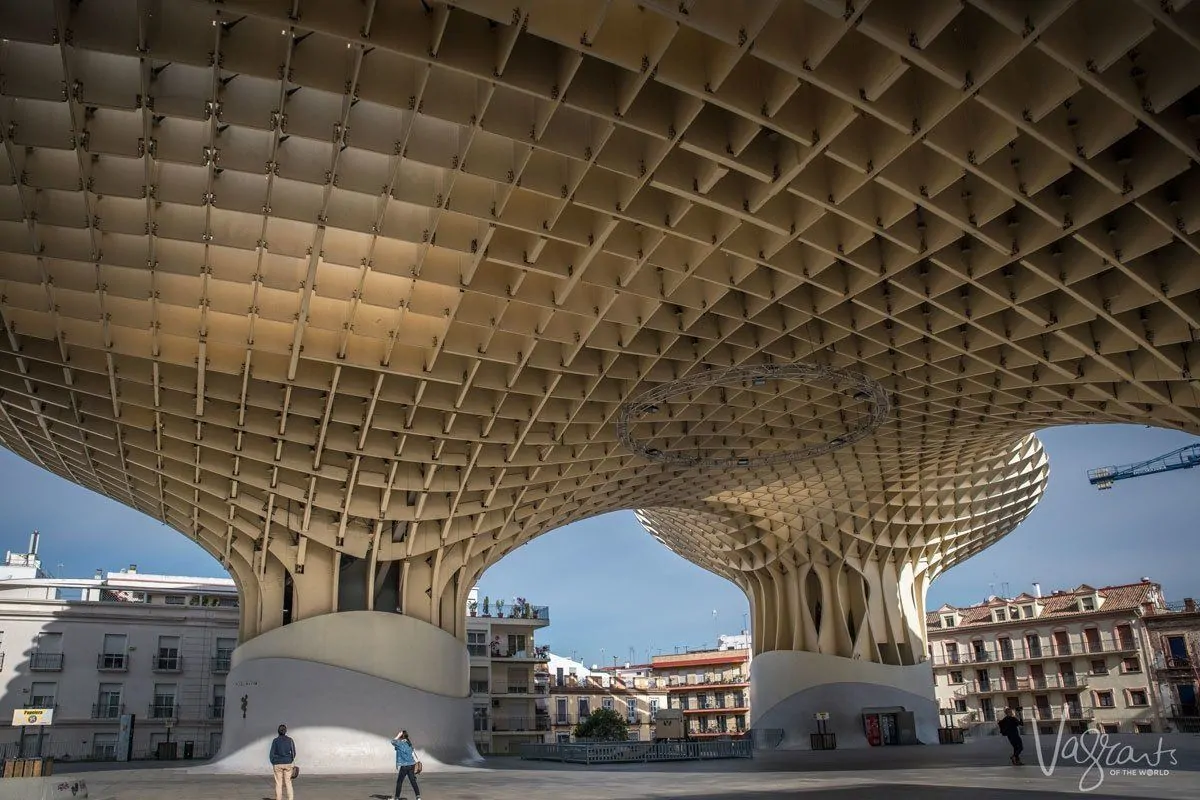
There is so much to see and do in the Andalucían capital; we have dedicated a complete guide to the best things to do in Seville.
Geographically, besides being one of Spain’s most beautiful cities, Seville is the ideal place to base yourself to explore Andalucía and Southern Spain.
With the ease of access to the international airport and affordable car hire options, it is possible to plan a relaxing and very affordable self-drive side trip such as a 3 day Pueblos Blancos tour from Seville. Need help deciding on accommodation in Seville? See our guide on the best places to stay in Seville for tips on the best neighborhoods and hotels.
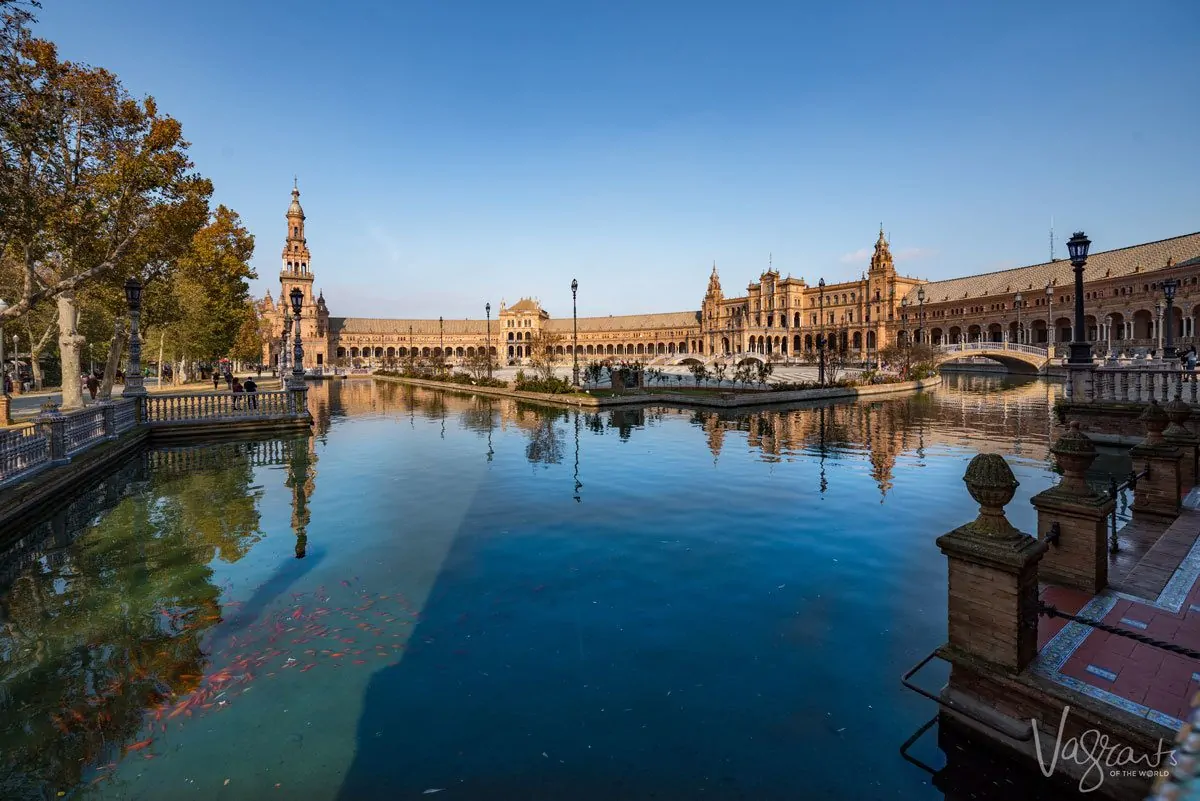
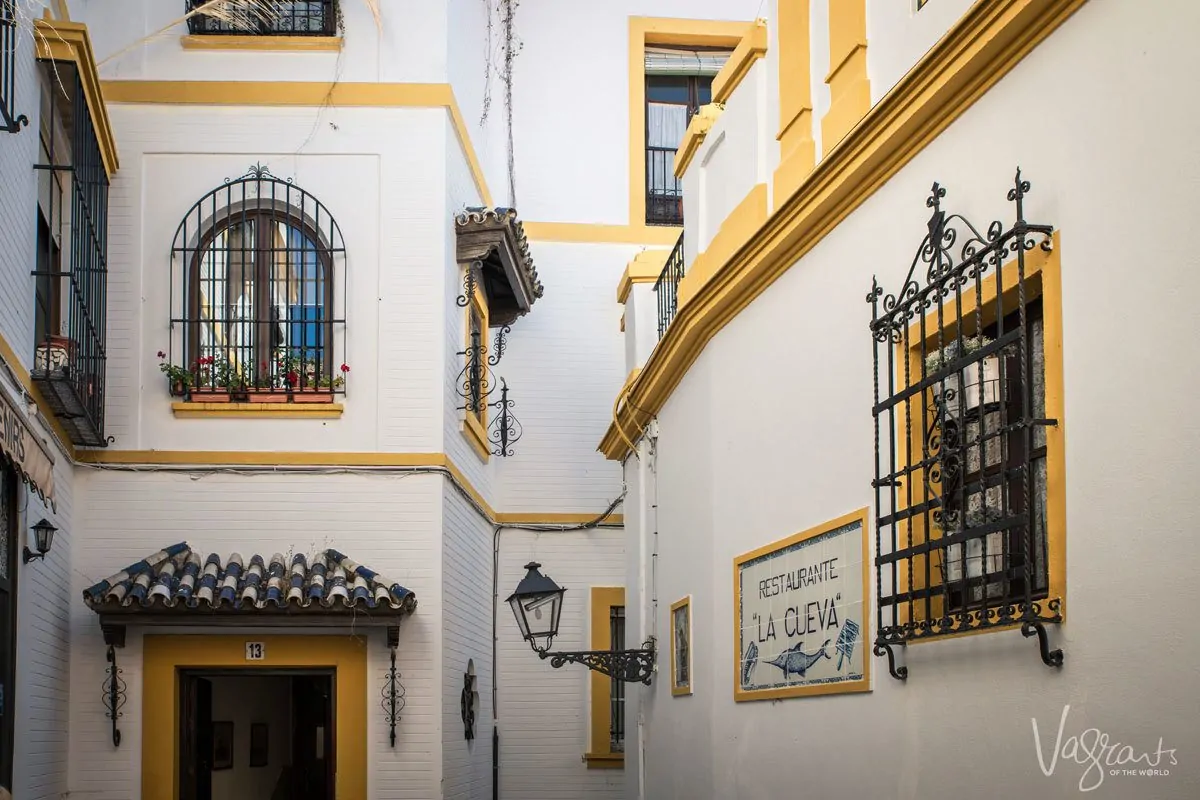
Arcos de la Frontera
Considered the gateway to the Pueblos Blancos of Andalucía, Arcos de la Frontera is more of a town than a village.
Declared a historical monument, it is one of the most beautiful villages in Southern Spain. A flood of Moorish influenced white houses spill down the edge of the rocky limestone cliff tracing the line of Río Guadalete.
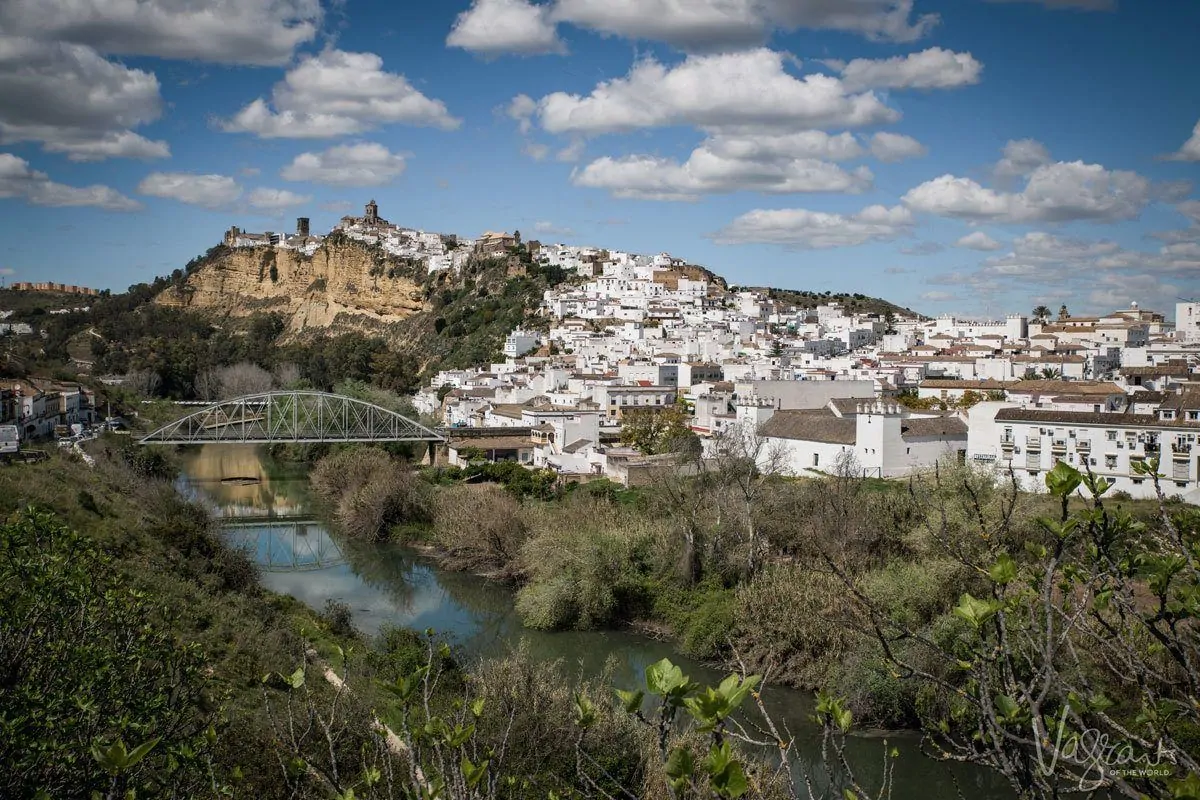
The fortified stronghold of Arcos has a fascinating and dark history. A Moorish fortress in the 11th century, Arcos was taken by the Christians to become a focal point between the caliphates and crusaders in Medieval times.
Arcos has also inspired many famous Spanish artists and musicians throughout history.

The beautiful narrow twists of steep streets typical of the region hold many historical landmarks, artisan boutiques and plenty of great restaurants to try the acclaimed regional cuisine.
Arcos de la Frontera is where you can appreciate Muslim, Gothic, Renaissance, and Baroque art. The town has one of the best examples of Andalucian fortified castles and some magnificent churches. One of the most impressive is the church of San Pedro with the ornate 18th-century baroque belfry built staggeringly close to the edge of the sheer cliff face.
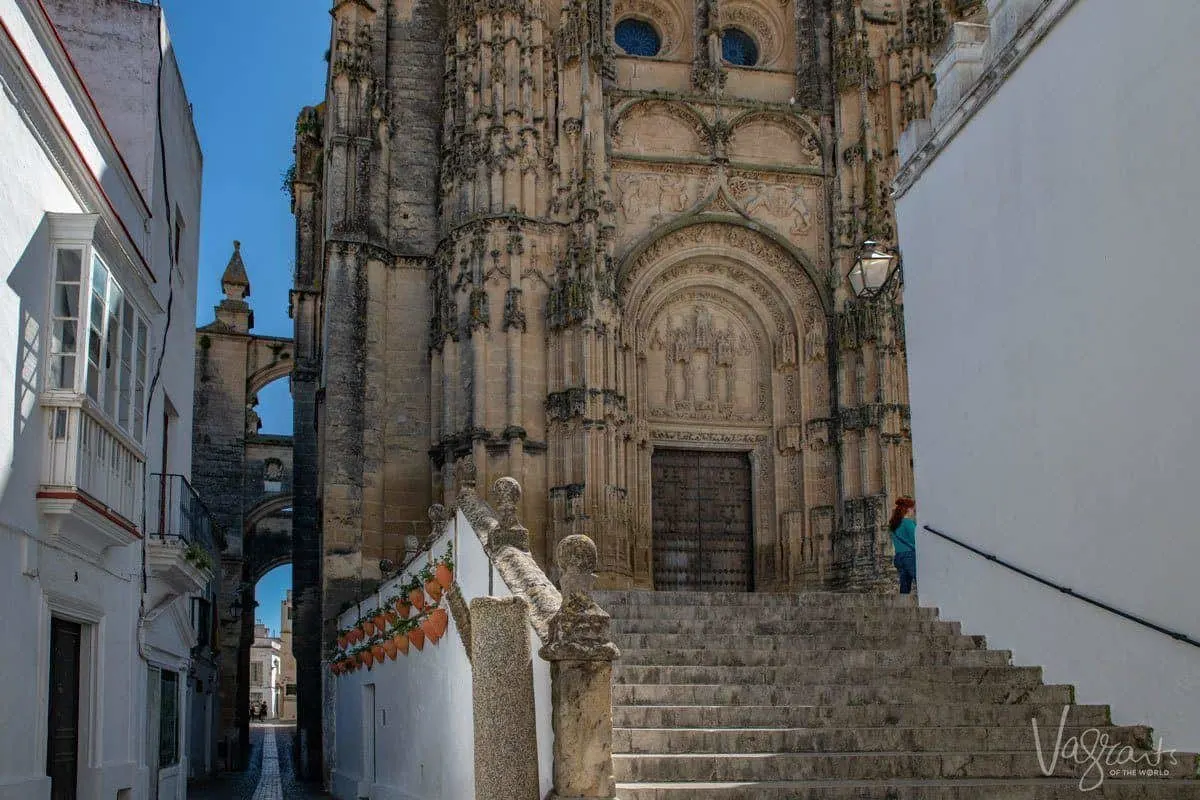
Aside from the beauty of Arcos de la Frontera and its fascinating history and architecture, the town is also known for its Easter celebrations and the 3-day Feria de San Miguel in late September to honour the town’s patron saint.
If you decide to stay in Arcos de la Frontera – for the ultimate experience, stay at the Parador de Arcos de la Frontera. The elegant hotel in the historical centre offers sweeping views of the town and the Guadalete River.
Zahara de la Sierra
Only 53 km from Arcos de la Frontera, the delightful village of Zahara de la Sierra sits at the base of the steep hillside beneath the remains of a Moorish castle.
Like Arcos, Zahara was the site of many battles between Moorish and Christian rulers. The Christians eventually took the village in the 15th century.
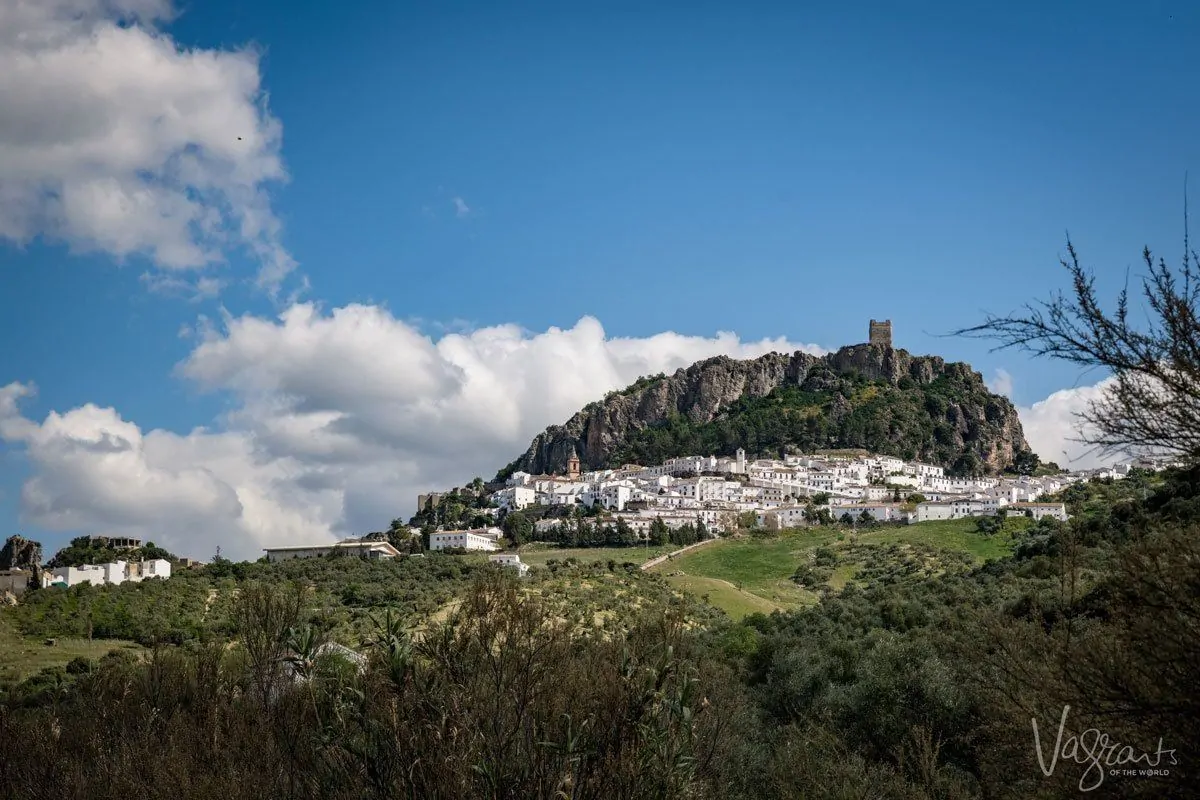
From the top of the village, you have a beautiful outlook over the blue-green waters of the Zahara-el Gastor reservoir, which makes it the perfect town at the height of the Spanish summer.
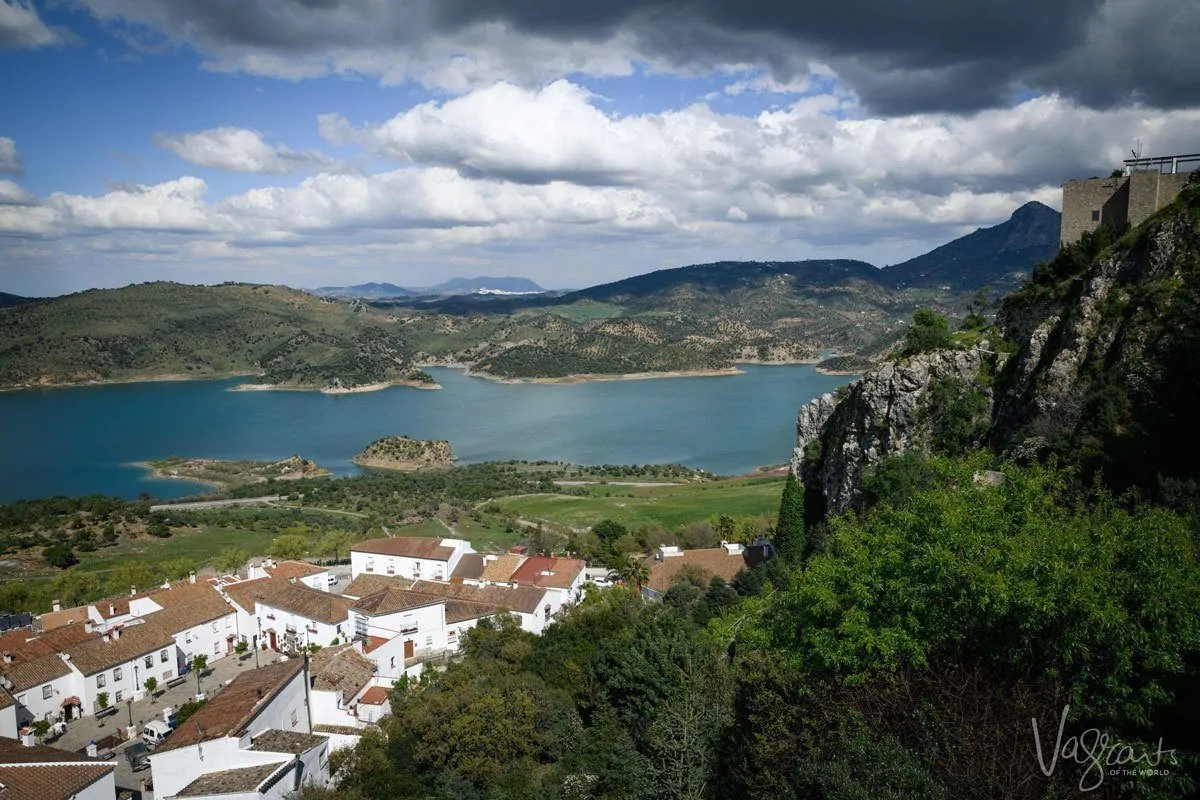
Zahara de la Sierra is famous for its fiesta of Corpus Christi around Easter time. The lively traditional religious festival has become a popular tourist attraction thanks to elaborate decorations placed all over the town.
Spring and early summer are also favourite times for hikers and nature lovers as the surrounding fields are in full bloom with wildflowers, and the weather is still mild.
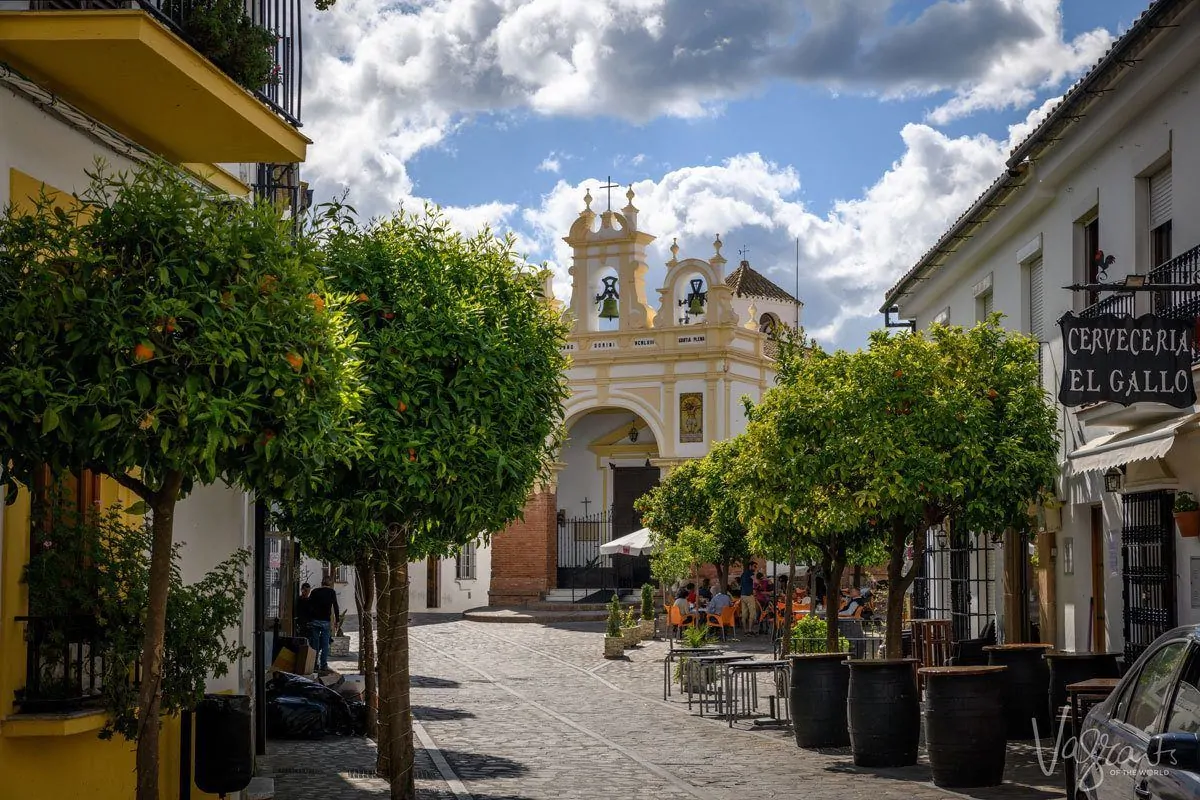
Grazalema
Grazalema is a high mountain village nestled in a valley surrounded by the Parque Natural de Sierra de Grazalema in the northeast of the Cádiz province.
The small village, surrounded by limestone mountains, has a unique microclimate, making it one of Spain’s rainiest places. This unique microclimate accounts for the massive range of flora in the area and makes it a very popular base for hikers and nature enthusiasts.
There are a lot of hiking and walking trails around Grazalema; just be aware that some require written permission to access. Check before setting off. You can find some information on the Sierra de Grazalema hiking trails here.
Grazalema village is a charming jumble of quaint whitewashed houses adorned with colourful pots of flowers, narrow alleyways and a postcard-ready town square lined with restaurants and bars. It is no wonder the mountain village recently earned the title of one of Spain’s prettiest villages.
Aside from charm and spectacular scenery, Grazalema is also known for its traditional crafts, a history that is on display at the Traditional Textile Museum in town.
From Grazalema, it is only a little over 40 min to Ronda. Arrive in time to relax before heading out to enjoy Ronda’s exciting restaurant scene. Remember, dinner in Spain always starts late. Don’t expect too many restaurants to open before 8.00 pm for dinner.
DAY 2
Spend a full day and night exploring beautiful Ronda.
Ronda
There is a good reason we have based this 3-day white villages itinerary around two nights in Ronda. Not only is it the largest of the Pueblos Blancos, it is conveniently placed for such an itinerary, and there is also so much to see and do in Ronda; two nights are warranted, so you don’t have to rush.
Everything about Ronda seems dramatic. From the dizzying heights at which the small city sits – on the edge of a cliff, to the Puente Nuevo, which straddles the 98-metre deep ravine of the El Tajo Gorge. The bridge finished in 1793, and took 42 years to build.
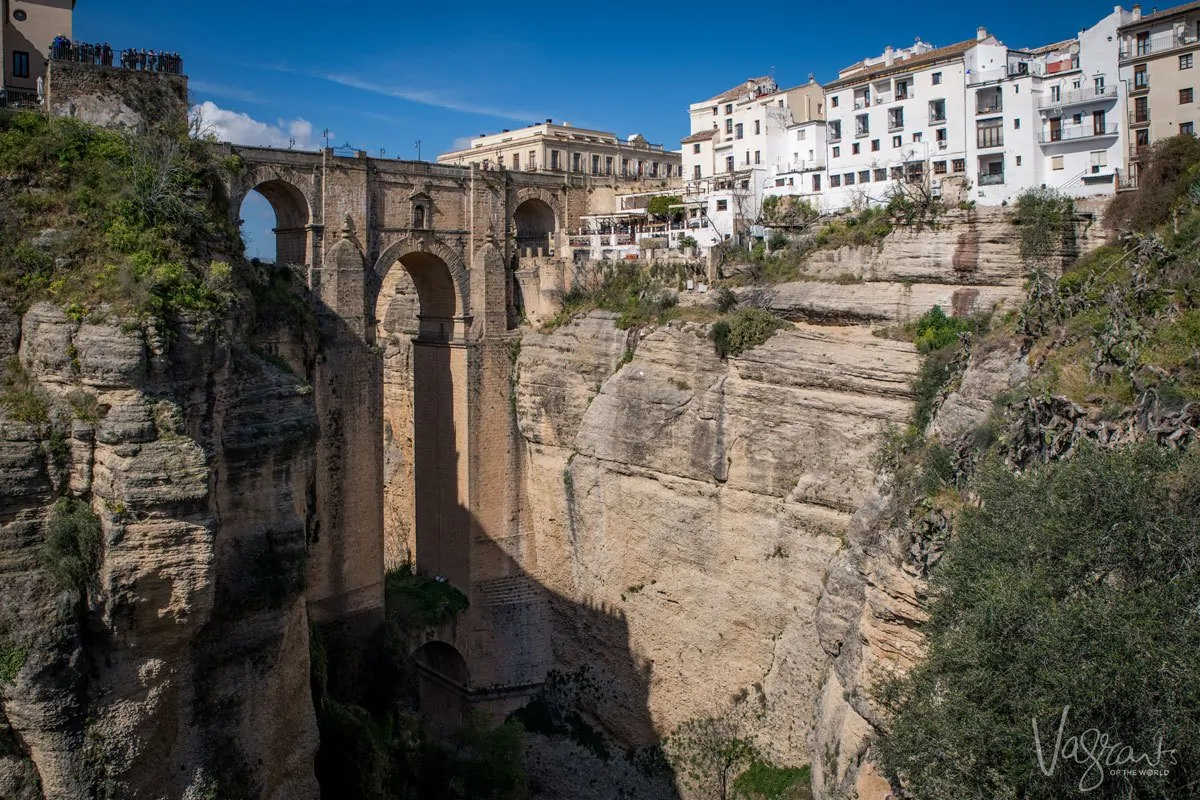
Ronda also lays claim to Spain’s second oldest bullring. Hemingway was so taken with the romance of Ronda and bullfighting, that he immortalised the town, the passion and drama of the sport in several novels.
The bullring, the largest sand circle in the world, is home to the Real Maestranza de Caballería de Ronda. With a heritage going back to 1485, it is Spain’s oldest and most noble order of horsemanship.
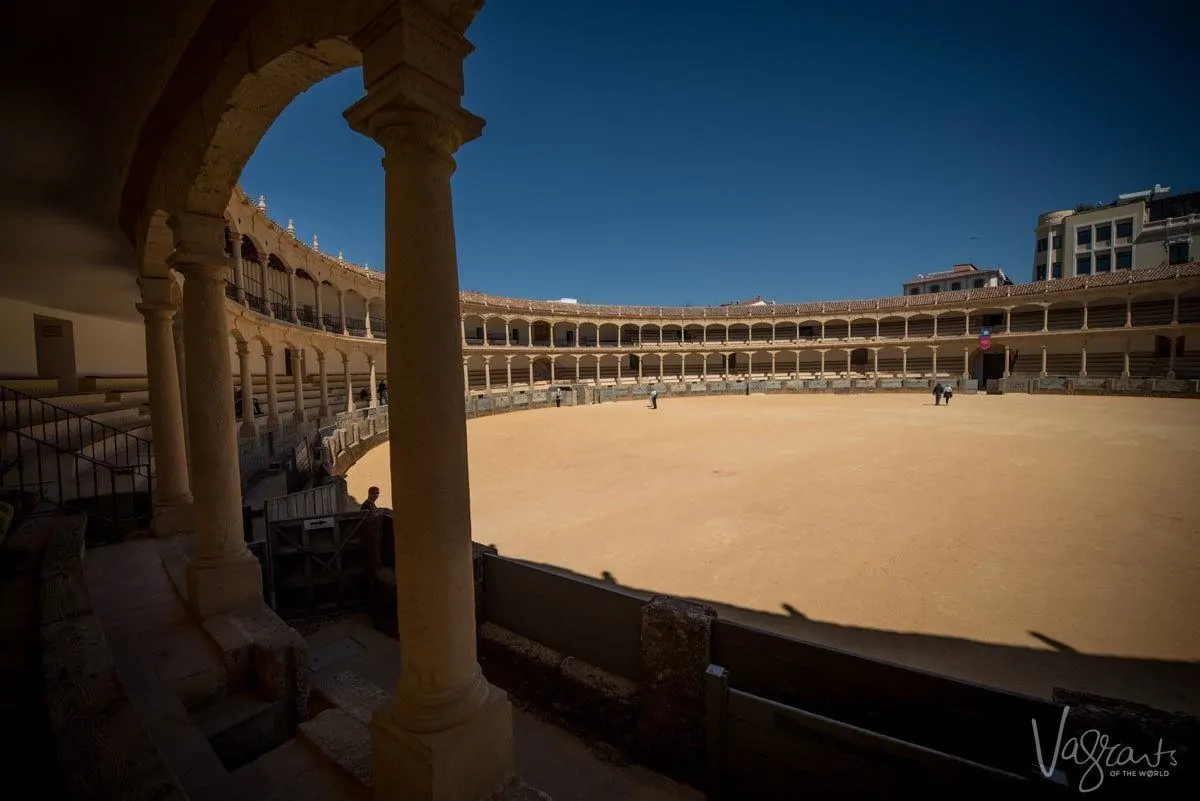
Ronda is loaded with cultural treats beyond bullfighting and famous artists such as Hemingway, who were drawn to the romantic outlook of the town.
Ronda has a rich Moorish heritage – from the narrow whitewashed streets, the Moorish Mondragon palace with its museum and tranquil gardens to the 13th-century Arab Baths in Barrio de San Miguel, a design based on the bathhouse of the famous Alhambra. It is also the best-preserved Arab bath in Spain.
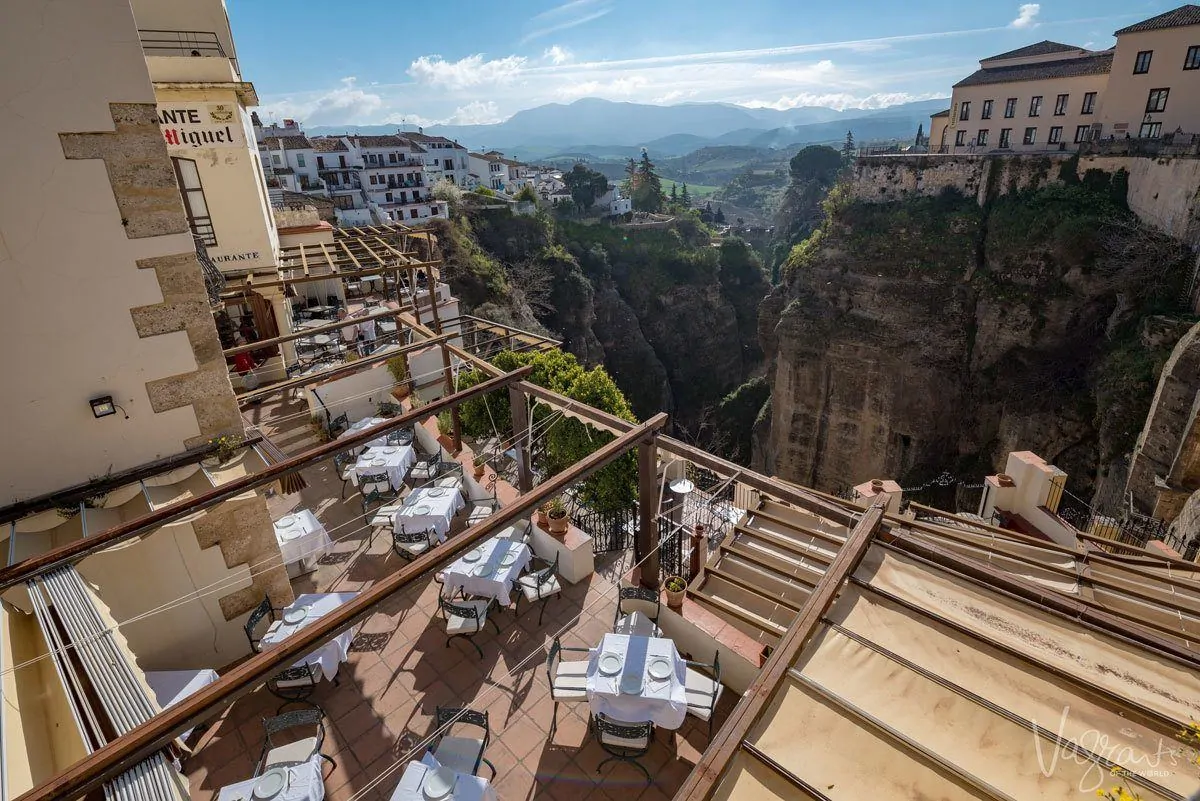
In spring and summer, Ronda comes alive with festivals. The traditional agricultural festival – the May Fair, the Feria de Pedro Romero in early September, which features folkloric shows, flamenco singing, and Goyaesque bullfighting. There is also the Roman Pilgrimage that reenacts a fiesta of ancient Rome.
Search Accommodation Deals in Ronda
Tip: If self-driving, make sure you confirm your accommodation has parking. Ronda has limited street parking options and very few paid parking lots.
Booking.com
Tip: Spending longer in Ronda? Take a 2o minute drive to the Cueva del Gato (cat’s cave) to take a swim in one of Andalucía’s natural monuments. Or, if you have time, include it as a stop en route from Grazalema.
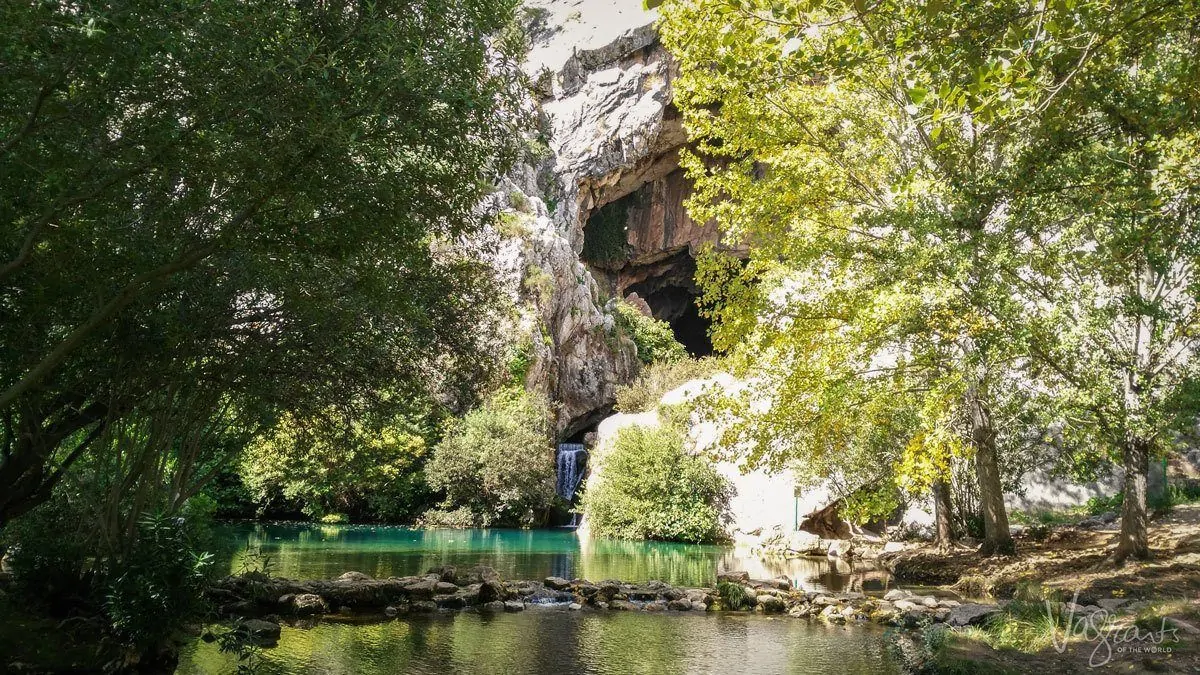
DAY 3
- Ronda
- Setenil de las Bodegas
- Olvera
- Return to Seville
Enjoy the morning in Ronda before making the short drive to the fascinating village of Setenil de las Bodegas, only half an hour from Ronda.
After Setenil de las Bodegas, make your way to Olvera only 30 minutes further along the route. Olvera is an excellent place for a leisurely lunch before returning to Seville.
Setenil de las Bodegas
Thirty minutes from Ronda, Setenil de las Bodegas is one of the more unique Pueblo Blancos.
The ancient town settled in the 12th- century was originally built into the rocks to regulate indoor temperatures. The ruins of a Moorish castle reside above the medieval village, a reminder of the Islamic heritage.
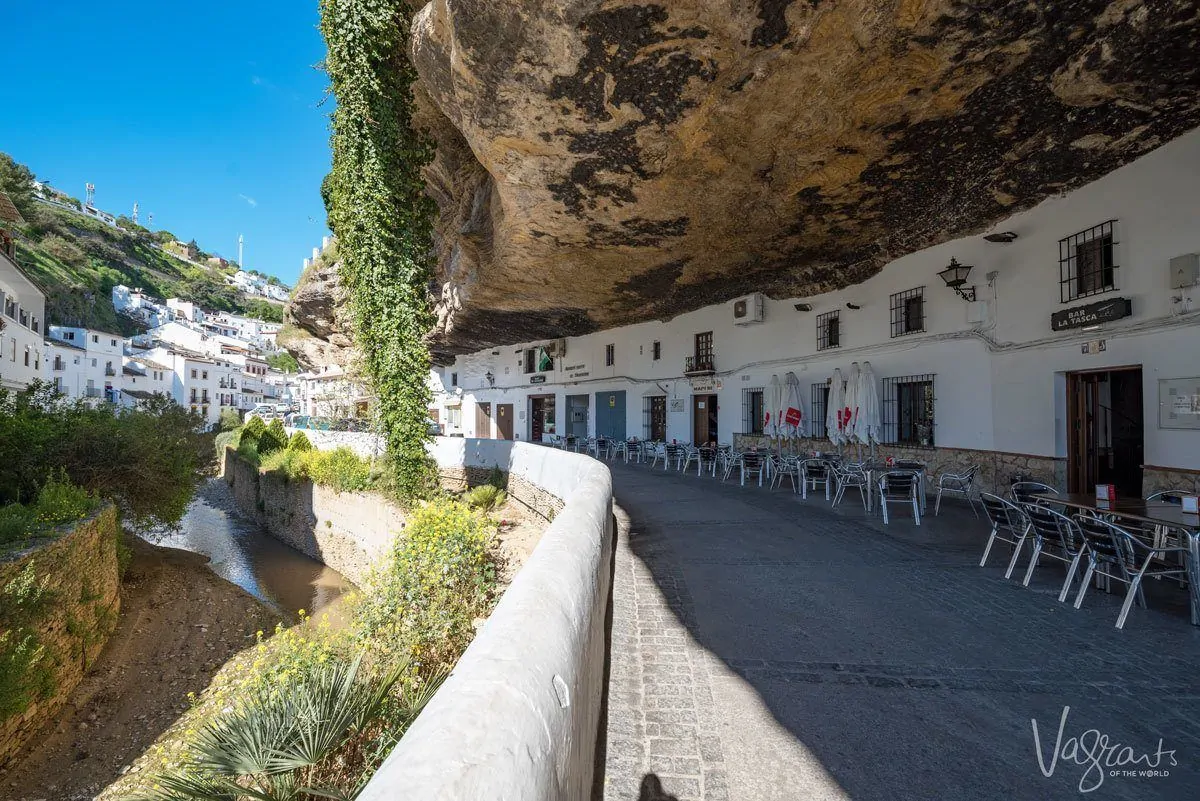
The town as it stands today has grown from the collection of cave dwellings. Many of the more modern residences are still hewn from rock. Rows of whitewashed shops, restaurants, and houses sit under the immense weight and shelter of the rocky overhang.
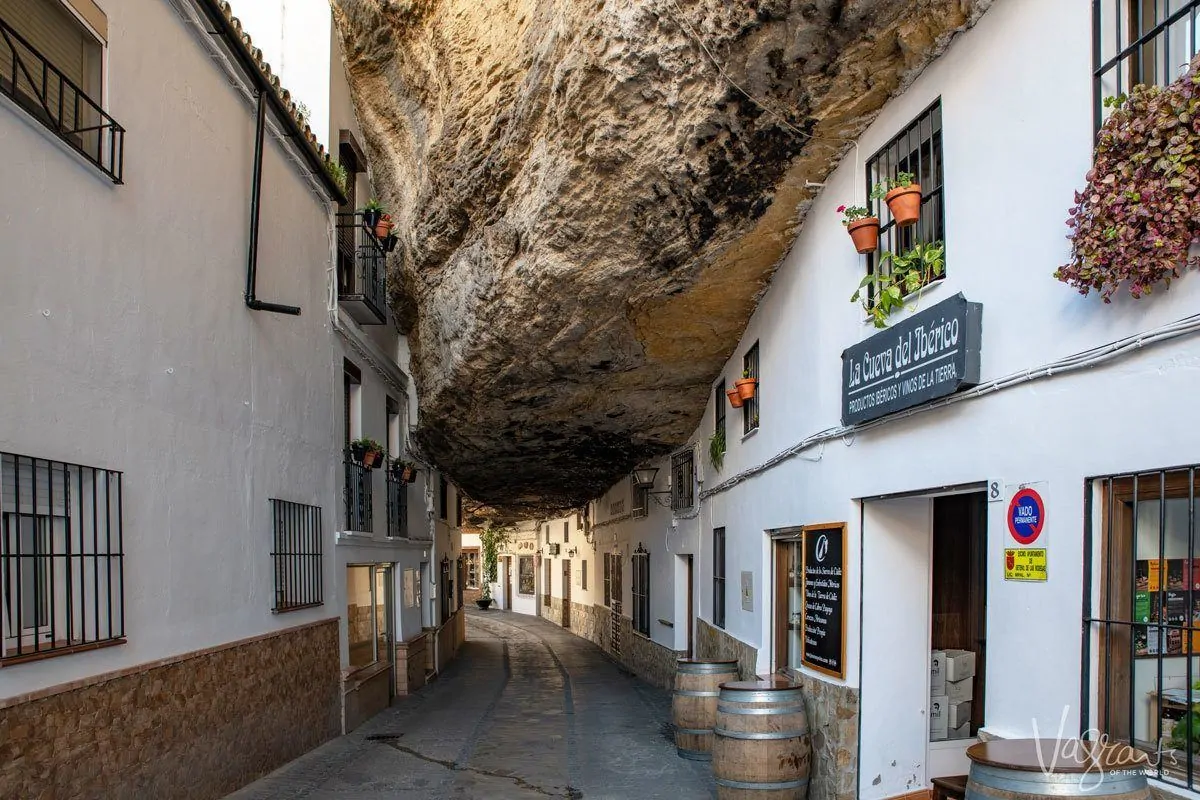
It is a charming and intriguing village to walk around. Enjoy lunch or a drink at one of the bars or restaurants that overlook the small river hiding beneath the shade of the great boulder. Or, drive to the top of the village for great views back across the town and countryside.
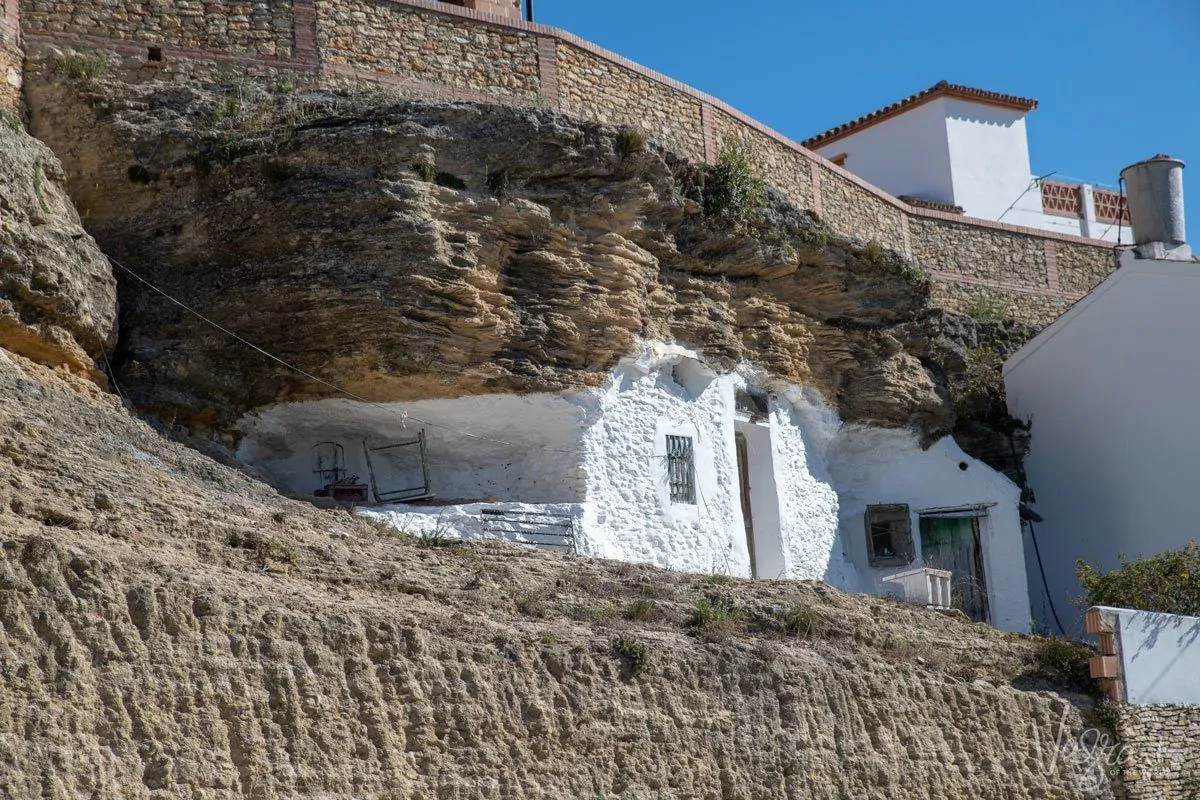
Olvera
Described as one of the most charismatic Pueblos Blancos in the mountains of Cadiz, Olvera is undoubtedly one of the most recognisable from a distance.
Set among wooded hills and olive groves, Olvera lies between the Sierra de Líjar and the Sierra de las Harinas mountains.
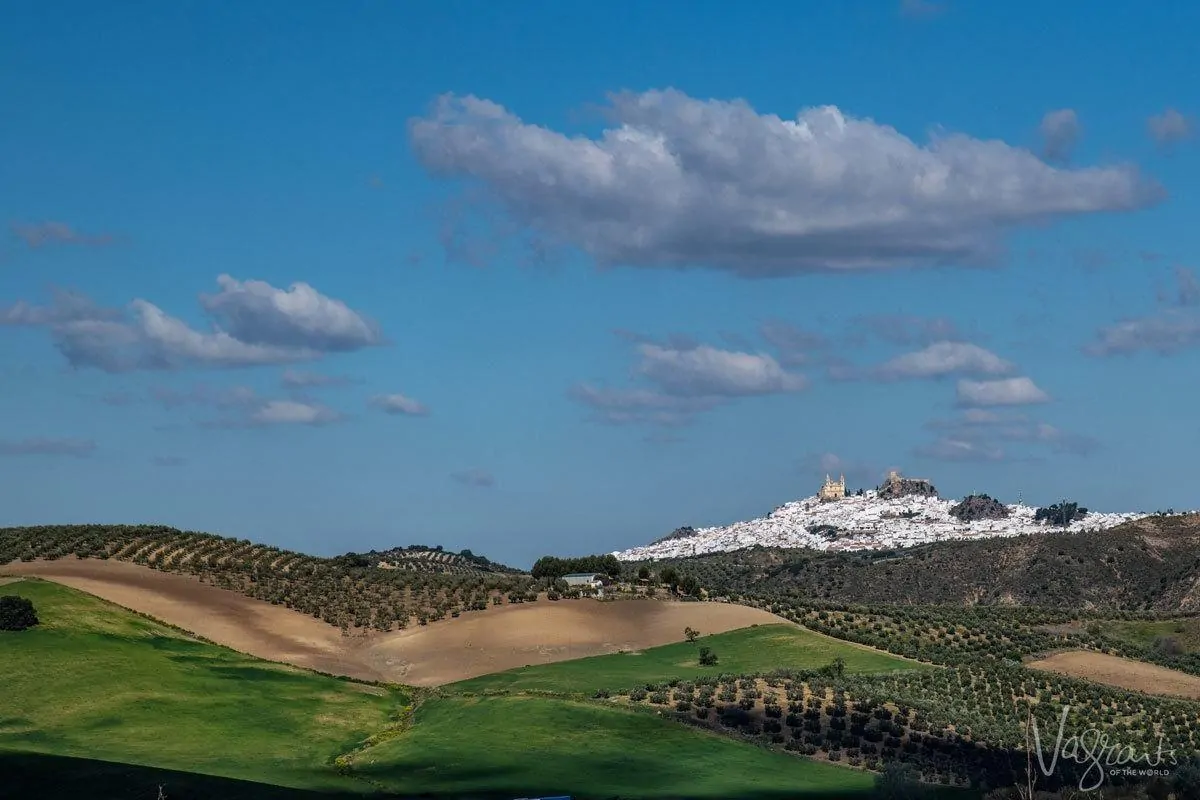
As you approach, the two most prominent buildings catch your eye before you can even see the beautiful display of whitewash covering the hill. The neoclassical Encarnación Church and old Arab castle punctuate the skyline making up the classic view of Olvera.
The views of the surrounding mountains from the church and castle at the top of the town are breathtaking. Olvera is a delightful stop for lunch before returning to Seville.
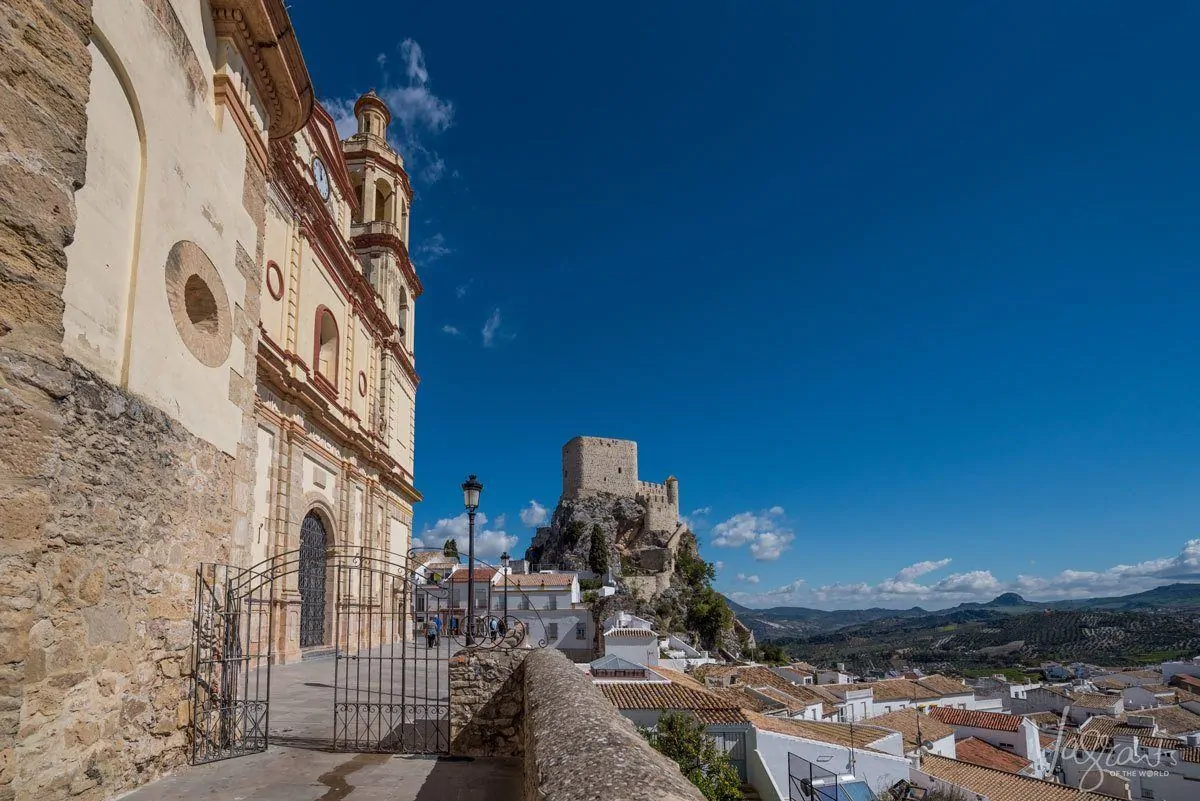
Olvera town runs down the hill leading away from the church and the castle so expect an uphill climb as soon as you arrive. While it may be tempting to drive straight to the top of the town, parking can be problematic in the historic centre, especially in the peak summer months.
Navigating the series of tight, mostly one way streets may be challenging for some. If in doubt, park down at the bottom and walk up to the town hall square; it will be worth it.
From Olvera, it is less than 100km back to Seville. You can make a few other white village detours if you have the time, as shown on the map below.
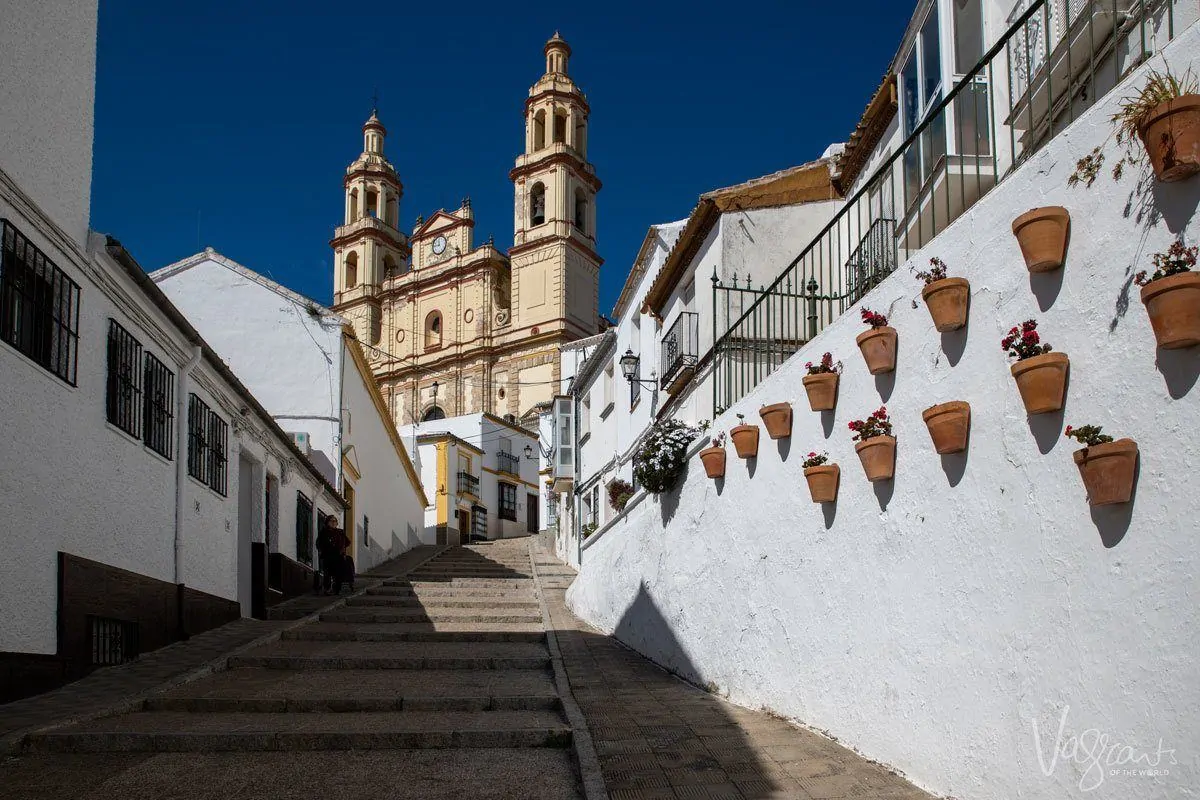
Want to Visit More of the Pueblos Blancos of Andalucía?
Got more than three days in Southern Spain and want to visit more white villages? Here is a map of all the white villages, including the ones we have listed in our 3-day itinerary. If you have the time in Andalucía, you can plan your own extended Pueblos Blancos itinerary.
- Alcala del Valle
- Aalgar
- Algodonales
- Arcos de La Frontera
- Benaocaz
- Bornos
- El Bosque
- El Gastor
- Espera
- Grazalema
- Olvera
- Prado del Rey
- Puerto Serrano
- Ronda
- Setenil de las Bodegas
- Torre Alhaquime
- Ubrique
- Villaluenga del Rosario
- Villamartín
- Zahara de la Sierra


